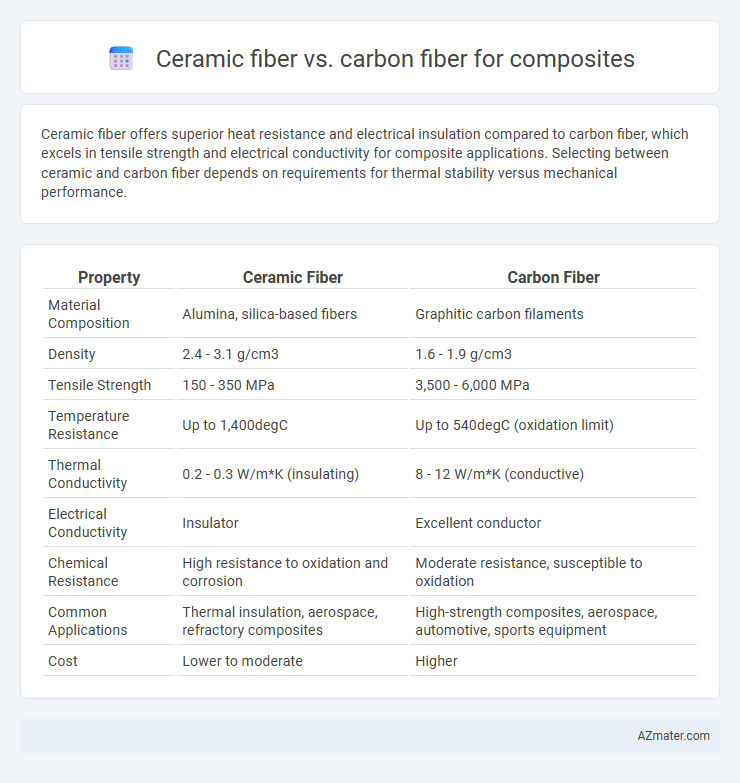Ceramic fiber offers superior heat resistance and electrical insulation compared to carbon fiber, which excels in tensile strength and electrical conductivity for composite applications. Selecting between ceramic and carbon fiber depends on requirements for thermal stability versus mechanical performance.
Table of Comparison
| Property | Ceramic Fiber | Carbon Fiber |
|---|---|---|
| Material Composition | Alumina, silica-based fibers | Graphitic carbon filaments |
| Density | 2.4 - 3.1 g/cm3 | 1.6 - 1.9 g/cm3 |
| Tensile Strength | 150 - 350 MPa | 3,500 - 6,000 MPa |
| Temperature Resistance | Up to 1,400degC | Up to 540degC (oxidation limit) |
| Thermal Conductivity | 0.2 - 0.3 W/m*K (insulating) | 8 - 12 W/m*K (conductive) |
| Electrical Conductivity | Insulator | Excellent conductor |
| Chemical Resistance | High resistance to oxidation and corrosion | Moderate resistance, susceptible to oxidation |
| Common Applications | Thermal insulation, aerospace, refractory composites | High-strength composites, aerospace, automotive, sports equipment |
| Cost | Lower to moderate | Higher |
Introduction to Ceramic Fiber and Carbon Fiber
Ceramic fiber is a high-temperature resistant material primarily composed of alumina and silica, used for thermal insulation in composites requiring heat stability and fire resistance. Carbon fiber consists of thin strands of carbon atoms bonded in a crystalline structure, offering exceptional strength-to-weight ratio and stiffness ideal for lightweight, high-performance composites. Both fibers serve distinct roles in advanced composites depending on thermal, mechanical, and durability requirements.
Material Composition and Structure
Ceramic fibers are primarily composed of alumina, silica, and other oxides, featuring a highly crystalline and brittle microstructure that provides excellent heat resistance and thermal stability in composite materials. Carbon fibers consist mainly of carbon atoms arranged in a graphitic, hexagonal lattice, resulting in high tensile strength, low weight, and superior electrical conductivity. The amorphous structure of ceramic fibers contrasts sharply with the ordered carbon fiber structure, influencing their mechanical performance and application suitability in composite manufacturing.
Mechanical Properties Comparison
Ceramic fiber composites exhibit exceptional high-temperature resistance and excellent compressive strength, making them ideal for thermal insulation and aerospace applications. Carbon fiber composites provide superior tensile strength, higher stiffness-to-weight ratio, and greater fatigue resistance, which are critical for automotive and sporting goods industries. The choice between ceramic and carbon fiber depends on whether heat tolerance or mechanical load performance is prioritized in the composite design.
Weight and Density Differences
Ceramic fiber composites exhibit higher density, typically around 2.5 to 3.2 g/cm3, compared to carbon fiber composites which have a lower density ranging from 1.6 to 1.8 g/cm3, making carbon fibers significantly lighter. The reduced weight of carbon fiber composites enhances performance in aerospace and automotive applications by improving strength-to-weight ratios and fuel efficiency. Conversely, ceramic fibers offer superior thermal resistance and stability but at the cost of increased weight, limiting their use where minimal mass is crucial.
Thermal Performance and Heat Resistance
Ceramic fiber composites offer superior thermal performance with heat resistance up to 1,800degC, making them ideal for high-temperature insulation and refractory applications. Carbon fiber composites provide excellent strength-to-weight ratios but typically withstand lower continuous temperatures around 400degC to 600degC before degradation. The choice depends on operational thermal demands, with ceramic fibers preferred for extreme heat environments and carbon fibers suited for structural applications requiring moderate heat resistance.
Chemical Resistance and Durability
Ceramic fibers exhibit superior chemical resistance against acids, alkalis, and high-temperature oxidation, making them ideal for harsh chemical environments in composite applications. Carbon fibers offer exceptional mechanical durability and fatigue resistance but are prone to degradation by strong oxidizing agents unless properly coated or treated. Selecting ceramic fibers enhances chemical stability and longevity in corrosive settings, while carbon fibers prioritize structural durability under mechanical stress.
Cost Analysis and Affordability
Ceramic fiber composites generally offer lower raw material costs compared to carbon fiber composites, making them more affordable for high-temperature applications such as thermal insulation and fire protection. Carbon fiber composites, while more expensive upfront due to complex manufacturing and precursor materials, provide superior strength-to-weight ratios and durability that can reduce long-term maintenance and replacement expenses. Cost analysis should consider the total lifecycle expenses, where ceramic fibers excel in cost-sensitive, thermal resistance roles, whereas carbon fibers deliver value in performance-critical, lightweight structural applications.
Applications in Composite Industries
Ceramic fiber excels in high-temperature insulation and thermal barrier applications within the aerospace and automotive industries due to its exceptional heat resistance and chemical stability. Carbon fiber is preferred in structural composites for aerospace, automotive, and sporting goods because of its superior strength-to-weight ratio and excellent fatigue resistance. Both fibers enhance composite performance, with ceramic fibers prioritizing thermal protection and carbon fibers delivering mechanical strength and lightweight benefits.
Environmental Impact and Sustainability
Ceramic fibers offer superior thermal resistance and chemical stability, making them ideal for high-temperature composite applications with lower environmental degradation during manufacturing compared to carbon fibers. Carbon fiber composites, while strong and lightweight, involve energy-intensive production processes and have limited recyclability, contributing to higher carbon footprints and waste management challenges. Advancements in recycling technologies for carbon fibers and the use of bio-based resins are improving the sustainability profile of both materials in composite manufacturing.
Choosing the Right Fiber for Your Composite Needs
Ceramic fiber offers exceptional high-temperature resistance and insulation properties, making it ideal for aerospace and industrial thermal protection composites. Carbon fiber provides superior tensile strength, stiffness, and lightweight characteristics, suited for automotive, sports equipment, and structural applications. Selecting the right fiber depends on specific composite requirements such as thermal stability, mechanical performance, and weight constraints.

Infographic: Ceramic fiber vs Carbon fiber for Composites
 azmater.com
azmater.com